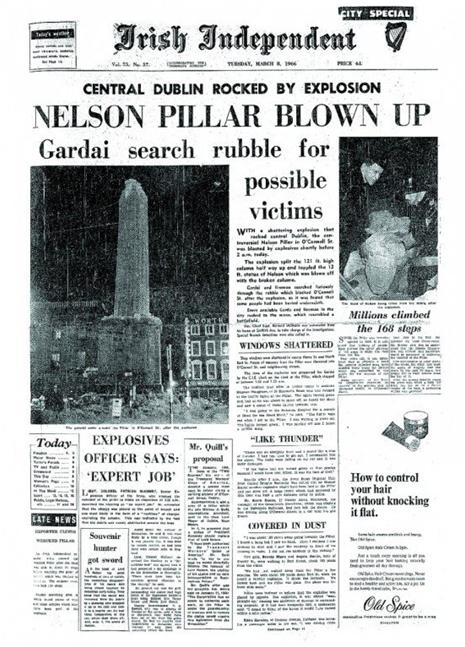
The bombing of Nelson's Pillar, 1966 At 1:32 a.m. on the morning of March 8th, 1966 a large explosion echoed through the heart of Dublin. Nelson's Pillar, which had dominated the Dublin skyline for over 150 years was bombed by a republican splinter group who called their attack "Operation Humpty Dumpty." No one was hurt by the explosion. The 13ft statue of Britain's greatest naval hero, Horatio Nelson, stood on a column of stone that was 121ft tall, about one third the height of the Spire which now stands in its place. Built in 1809, the pillar was a great public attraction. For a few pence, you could climb the 168 spiral steps to a platform which gave a birds eye view of Dublin. However, it soon became a political embarrassment for successive Irish governments because it honoured a British war hero. A stump was left after the explosion and O'Connell Street was closed while army engineers were brought in to remove it. Their 'controlled' explosion caused much more damage than the original blast, much to the amusement of Dubliners. The rubble from the monument was taken to the East Wall dump and the lettering from the plinth moved to the gardens of Butler House, Kilkenny. Ken Dolan and six other students from the National College of Art and Design stole the statue's head on St. Patrick's Day from a storage shed in Clanbrassil Street as a fund raising prank to pay off a Student Unions debt. They leased the head for £200 a month to an antiques dealer in London for his shop window. It also appeared in a women's stocking commercial, shot on Killiney beach, and on the stage of the Olympia Theatre with The Dubliners. The students finally gave the head to the Lady Nelson of the day about six months after taking it. It now resides in the Gilbert Library on Pearse Street. The Nelson's Pillar Act was passed in 1969, transferring responsibility for the site of the monument from the Nelson Pillar Trustees to Dublin Corporation. The site was simply paved over by the authorities until the Anna Livia monument was installed there for the 1988 Dublin Millennium celebrations. This was moved in 2001 to make way for the Spire of Dublin, erected in its place in 2003.



